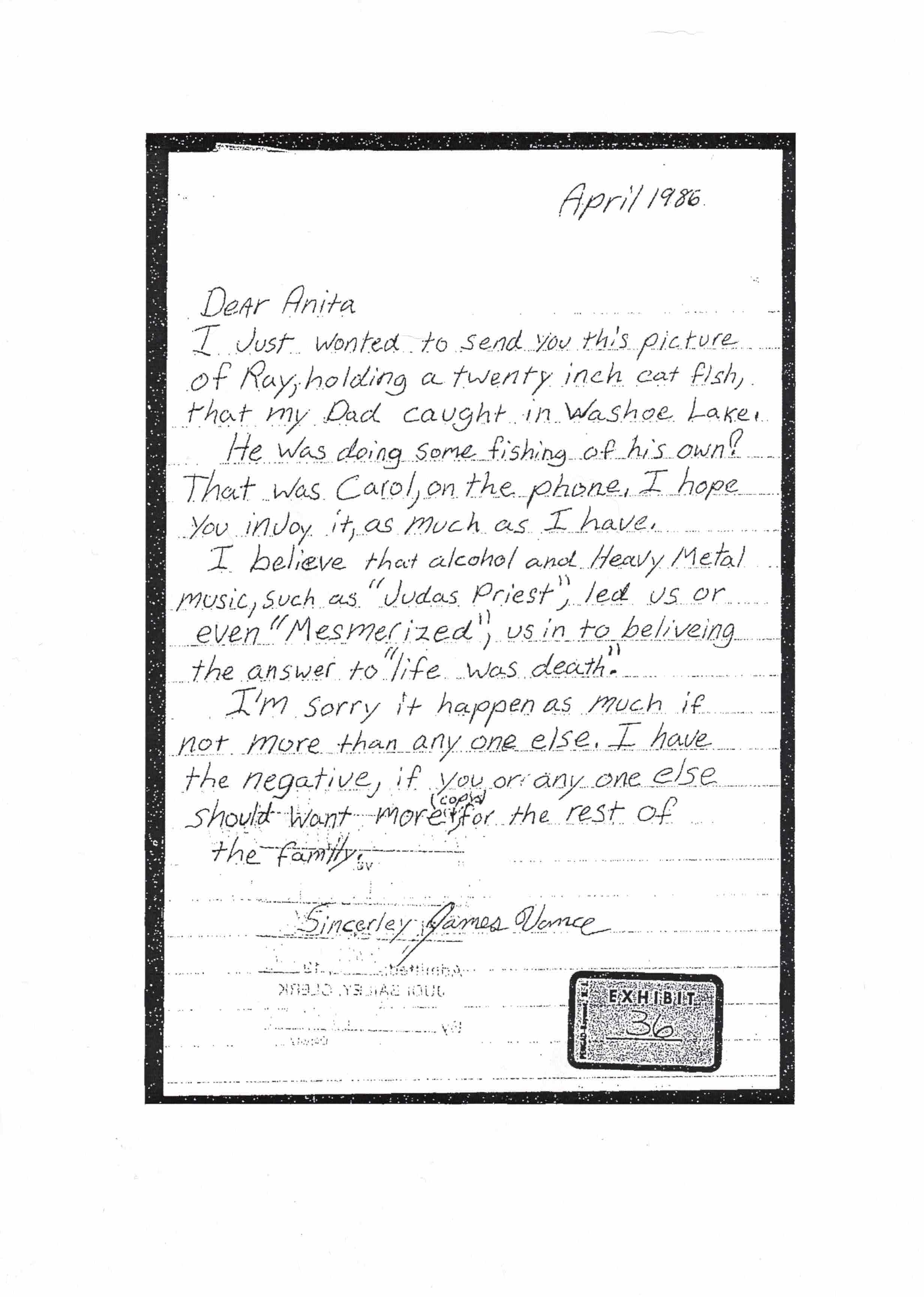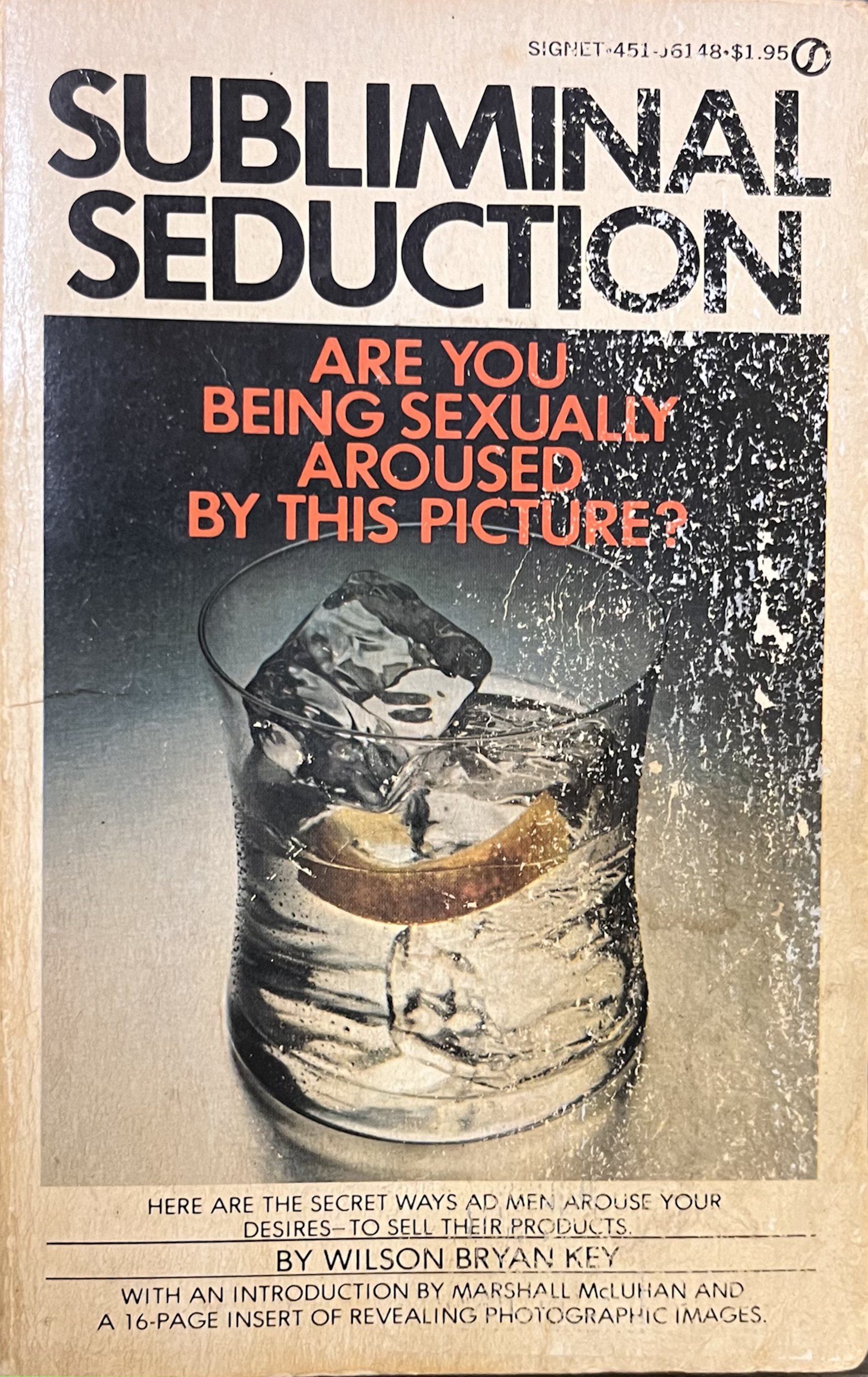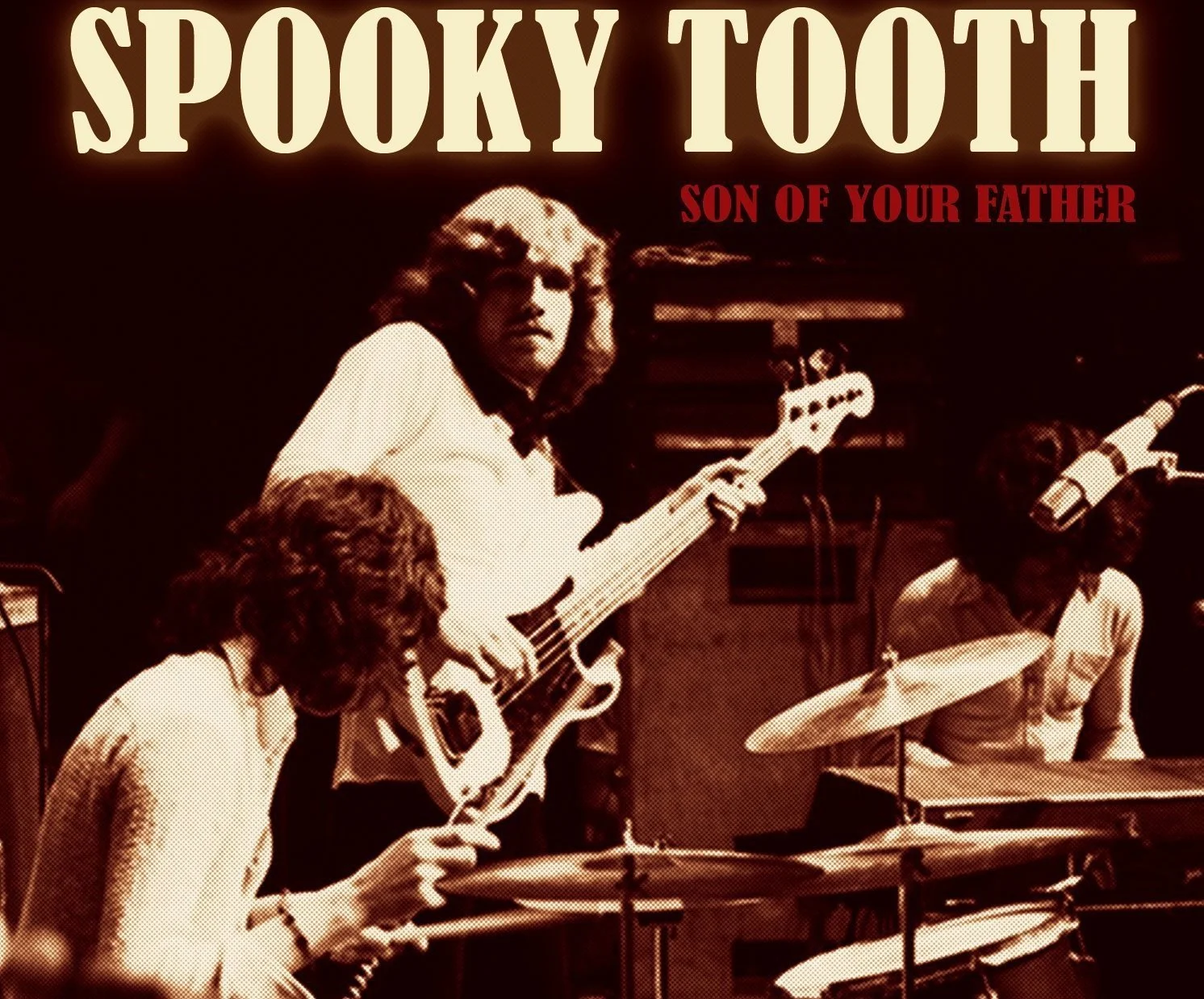Warning: this episode includes graphic descriptions of suicide.
In 1990 the Heavy Metal band Judas Priest went to court in Reno, Nevada for allegedly using subliminal messages in their music.
The following text post is an abridged version of the podcast episodes “Judas Priest on Trial” (parts 1 + 2). For the full story, audio examples and examination of the alleged subliminal messages, subscribe & listen above.Two days before Christmas, 1985 Ray Belknap and James Vance climbed out of Ray’s bedroom window in Sparks, Nevada. The 1978 Judas Priest album “Stained Class” spun on the turntable behind them as they made their way to a playground at the Church of God. Ray carried a 12-gauge shotgun.
Both Ray and James had dropped out of high school, and for the previous couple of years had been working then quitting menial jobs. They drank, smoked weed, and spent a lot of their time listening to Heavy Metal. James’ mom Phyllis Vance was convinced that James’ depression and his disaffected worldview stemmed from that music, and especially his all-time favorite band, Judas Priest. “He could quote the lyrics like scripture,” she said.
Phyllis had convinced James of this on a few occasions. At one point, he sold all of his metal albums to Recycled Records in Reno. But the prohibition never lasted. His closest friend Ray was a metalhead too, and for James’ 20th birthday, Ray bought him a copy of “Stained Class,” the record that spun on the stereo as they dropped into the church playground. The two sat on a metal human-propelled marry-go-round, and Ray lifted the shotgun to his own throat, pointing up. He told James “I sure f***ed my life up,” then pulled the trigger. Ray died instantly. James, terrified, pulled the gun from a puddle of his best friend’s blood, and he too shot himself in the head.
But somehow, James survived.
Exhibit 36 Case no. 86-5844 // James' letter to Ray’s mom Aunetta (spelled wrong in document)
“I believe that alcohol and Heavy Metal music, such as ‘Judas Priest’ led us or even ‘mesmerized’ us into believing that the answer to ‘life was death’” - James Vance
In the attempt, James had severely damaged his lower face under his eyes. He underwent extensive rhinoplasty at Stanford, and would be in and out of serious surgery for the next 3 years. Despite the injury, he was cogent.
In early 1986, Phyllis and James Vance went searching for an attorney. Through a friend at church, they found a Reno lawyer named Timothy Post.
In Tim’s words: “They said, are you a Christian attorney? I said, well, I am a Christian… I'm a Christian who happens to be an attorney.”
32 years later, I interview Post in his Reno office — a small commercial building in Midtown, dotted with Abraham Lincoln memorabilia.
“And… I turned them down. I said, no, you got a thing called the First Amendment. Free speech.”
“Amendment I. Congress shall make no law respecting an establishment of religion, or prohibiting the free exercise thereof; or abridging the freedom of speech, or of the press; or the right of the people peaceably to assemble, and to petition the Government for a redress of grievances.”
The first amendment, introduced as “Article the Third” in the Bill of Rights. September 25, 1789
Since the ratification of the Bill of Rights there have been many cases in the US supreme court that have built on this amendment, and changed it in key ways. The main exception that most people know is that it’s illegal to falsely yell “Fire” in a crowded theater. This phrase comes from a non-binding dictum by Oliver Wendel Holmes in a 1919 supreme court decision —Schenck v United States. Summarizing here, Holmes claimed that if speech creates a “clear and present danger” it is not protected.
Another landmark case in first amendment rights was in 1969 — Brandenburg v. Ohio — a complicated and hairy case involving the KKK. In short it ruled speech that incites unlawful action is not protected by the First Amendment. The Brandenburg Test is still used today, deciding if the speech is “directed to incite or produce imminent lawless action,” and is “likely to incite or produce such action.”
Courts have found time and again that the speech of artists, no matter how violent or subversive or political, is almost always covered by the first amendment.
While the Vance family was hiring Timothy Post, the family of Ray Belknap had hired Reno attorney Ken Mckenna. Speaking to Mckenna over the phone, he said “the purpose in filing the case initially was to just make a point, uh, to create, um, public awareness that these type of lyrics were existing, that there did seem to be a causal connection and that. Morally, ethically, the industry should be, you know, held to task, uh, for what they were doing…”
The cases would later merge, and though they didn’t expect the cases to be successful, McKenna and Post originally filed a civil complaint solely based on the lyrics. As Post put it, “ the case started out as lyrics that incited violence…”
In the original civil complaint, Post cited the lyrics to “Hero’s End”, the final song on the album.
Around this time, another lawsuit was filed for the suicide death of a teenager. In Riverside California, John Daniel McCollum had killed himself after allegedly listening to Ozzy Osbourne’s song “Suicide Solution.” Though on the surface that might sound like a smoking gun, the lyrics seem to refer to alcohol as a suicide solution: a liquid that kills the drinker.
“Wine is Fine but whisky’s quicker // Suicide is slow with Liquor”
Osbourne says the song was a response to the death of the AC/DC front man, who died a tragic alcohol-related death at a young age.
Ruling in favor of Ozzy Osbourne, the judge dismissed the case and the precedent was a clear judicial speed bump in the burgeoning movement to regulate the lyrics of heavy metal, punk and hip hop. And also, it seemed to highlight the underlying weaknesses of that movement. What seems like a suicidal anthem to some, is an unlikely anti-drinking ballad to others.
The case appeared to be headed for dismissal, but then, things took an unexpected turn. As a shot in the dark, Ken McKenna sent the album to Bill Nickloff, a biologist who moonlighted as an independent producer of subliminal self-help cassettes. According to McKenna, Nickloff created tapes out of his studio in Sacramento that aimed to help listeners lose weight or quit smoking.
Nickloff listened through the record and claimed that it was jam packed with subliminal messages.
Post remembers it not quite as a shot in the dark, but an encounter between McKenna and an ex-client, “My co-counsel did a divorce for Wilson Bryan Key, the subliminal expert. He got to talking to him… and he said, ‘Hey, are they're subliminals? You better find out.’”
Wilson Bryan Key was a professor and author of several popular books that dealt with subliminal messaging including Media Sexploitation and Subliminal Seduction.
When McKenna presented the possibility of subliminal messages to the judge, Jerry Carr Whitehead of the second judicial court of the state of Nevada chose not to dismiss. In short, he argued that subliminal messages would not fall under the purview of the first amendment, and were therefore actionable.
Key gave a lengthy (200+ page) deposition in the case, and appeared on news reports to play backwards recordings of Judas Priest songs. Key and Nickloff would be two of the plaintiff’s expert witnesses in the case.
Though Nickloff created cursory tapes illustrating the alleged subliminal messages, the record company responsible for Judas Priest ,CBS Records, was ordered to produce the 24-track master tapes. They dragged their feet for a long time, claiming the masters were lost before eventually producing the 24-track tapes. This angered the judge, though he would ultimately concur that these were to original tapes and not tampered with.
In 1988, James Vance died in the hospital. He had been on a litany of medication, and under extreme emotional duress after the accident. His family, along with the family of Ray Belknap, continued to trial after his death.
1990. It was a hot July day when Rob Halford, Ian Hill, Glenn Tipton and KK Downing, all members of Judas Priest, walked up the courthouse steps in downtown Reno. They were welcomed by a throng of metalheads — kids in leather and band t-shirts lined the sidewalk with handwritten signs. Images of this moment were captured by filmmaker David Van Taylor, who was shooting a documentary. The film, Dream Deceivers, is an excellent in-depth look at the case released in 1992. I caught up with David Van Taylor over video chat.
“The atmosphere in the courtroom was…mixed. I mean…some of it was quite absurd, and it was a media circus, as the expression goes.”
David filmed in the courtroom as the trial unfolded, and though the plaintiffs’ case was initially built on the work of Wilson Bryan Key, he didn’t play much of a role in the actual trial. Instead, the attorneys leaned on Dr. Howard Shevrin, an academic psychologist with strong accolades.
The Defense meanwhile hired their own expert on subliminal stimuli, a professor and prolific writer on the subject, Timothy Moore. Moore was partially there to challenge the work of Key, from a scientific standpoint.
“ I mean…he himself was not a scientist. He had no background in science. His books were popular, but they were, uh…. let me put it this way…. He was an outlier in terms of scientific credibility or standing.”
In his book Subliminal Seduction, Key offers several examples of his findings of subliminal messages. In one magazine ad for Gin, he shows a tall glass of clear liquid with a lime, overflowing with ice. He points your eye to 3 of the four ice cubes, where he has found the letters S E X. To him, this is clear evidence of tampering.
He then draws the readers eye to several faces he sees in the ice cubes. One, he claims is a reference to the WW2 graffiti character Kilroy, then to what he claims is the face of a woman in the ice.
Though I can vaguely see the S caused by the silhouette of the lime, and 3 horizontal lines that could be seen as an E, I do not see the X, or the Kilroy or the woman, and I especially do not see in the reflection of the bottle cap what Key sees: “a man’s legs and partially erect genitals.”
Key saw genitals in everything, he claimed the word SEX was everywhere, and that people were being secretly exposed to latent homosexuality, and as he laments in one college lecture, inter-racial cunnilingus.
Key often seemed to sense his readers’ skepticism and periodically backed up these claims with what he referred to as evidence. He said for instance that 90% of the test subjects agreed with his assessment in another example, finding gendered symbolism in ice-cubes. But something he never does in the book is explain who the test subjects were, what the experiment was or who conducted it. Through context clues, it seems that his experiments were conducted by him in his university classes by vote, though he never offers documentation.
The trial came down to a handful of examples of alleged subliminal messages. To hear examples and decide for yourself, listen to the podcast episodes above.
Nickloff presented his findings in court through a digital audio workstation, and a fairly imposing stereo set up. Though I was unable to get my hands on Nickloff’s original tapes, I did my best to recreate his findings based on his written testimony and transcripts of the trial.
“Better by You, Better than Me” original version by Spooky Tooth.
“Better by You, Better than Me” cover by Judas Priest.
It was unlikely that Judas Priest would ever end up in this courtroom. But what seemed like a fairly long-shot case to many, was being very seriously considered. So the band hatched a plan.
David Van Taylor: “They hit upon this idea that they would go into a studio in their off time. Play the music in question backwards and look for what they could hear. Which is a very smart and very theatrical idea, so that they could demonstrate to the judge that if there was anything backwards, that it was random essentially. And yet they were walking a thin line, right? Because if they seemed to be too theatrical or glib or presentational …then it might have backfired.”
In an extraordinary moment of the trial, Rob Halford carried a boombox up to the Judge. He stood just above Judge Whitehead, and cued up a tape from the album in reverse. It seemed like a risky move.
ROB HALFORD ( COURT TRANSCRIPT): “The backward interpretation is ‘I asked for a peppermint, I asked for her to get one’ and forward, ‘standby for exciter. Salvation is his task.’ So what we'll hear first is I asked for a peppermint, I asked for her to get one. “
Halford cued up a segment from the album’s first track, Exciter, and brings the court’s attention to the reverse lyrics, which when prompted, can clearly be heard as “I asked for a peppermint, I asked for her to get one.”
It’s really difficult to read his expression, the judge is stern. He looks down at his notes, hands folded, and then shifts his eyes up to the courtroom, looking far into the distance.
Rob Halford (Transcript Dream Decievers Documentary): “To be close to him like that was, was a real, real experience. I got the distinct feeling that the judge was thinking, oh dear… These guys are right…”
It seems that this theatrical risk has paid off. And so, after weeks of testimony, the court adjourns…
ORDER
• • •
James Vance vs. Judas Priest
It costs 50 cents/page to print at the courthouse. The final judgement runs me about 40 bucks. First, Judge Whitehead lays out a lengthy foundation. He is fully aware that this is an early judicial test of subliminal messaging, and seems to be putting his stamp on the caselaw. He cites Thomas Payne, Fergerstrom v. Hawaiian Ocean View Estates, the Magna Carta. Then sets up a legal argument for the exemption of Subliminal material from First Amendment protection.
Eventually he gets to the findings. First, the master 24-track tapes provided by CBS records are in fact the originals.
This had been a point of contention. CBS took forever to hand them over, and the plaintiffs saw that as evidence of possible tampering. The Judge did not agree, but fined CBS $40k for their foot-dragging.
Then, the important stuff. Does the “Stained Class” Record Contain Forward Subliminal Messages?
Page 17 line 21
Finding of Fact Number 2:
“The words “Do it” are present several times on the song “Better by you Better than me.”
…During the various demonstrations on special audio equipment when the sound was identified, isolated, amplified and the Court’s attention drawn to it, the Court could hear the words “Do it.”
Page 18 Line 7: Finding of Fact Number 3: “The DO ITS ON THE RECORD ARE SUBLIMINAL.”
Page 18 line 15: Finding of Fact Number 4: The Words Do it are the result of a chance combination of sounds: The words were not intentionally formed.
Despite finding subliminal “Do Its”, the judge found Judas Priest not liable for the suicide pact of Ray Belknap and James Vance.
The judgement goes on to say that the scientific research presented does not establish that subliminal stimuli can cause conduct of this magnitude.
Then, in what will likely stand as judicial precedent possibly in textbooks and public consciousness, the Judge writes that Ray Belknap and James Vance had behavioral problems in school, that they had a history of aggressive behavior, run ins with the law, drug and alcohol problems, a record of unstable employment, and violent fantasies. All of that on the official record.
Page 48 Line 7: “Conclusion: Since the defendants have prevailed on the ultimate issues in the case, there are those who may for that reason believe that this has been a one sided trial and that the plaintiffs have presented no credible evidence. Such a belief would be erroneous. After listening to all of the evidence presented during the four weeks of trial, the Court believes that the position taken by the plaintiffs in this action was an arguable one.”
Though causation was not proven, it is unknown what future information, research and technology will bring to this field.
Dated this 24th day of August, 1990
Jerry Carr Whitehead
Timothy Post: “Now that I've had a life to live since this case, I thought so then I think so even more now… I think we should have pounded the morals more. Show me where violent lyrics has done anything good, where it helps the human organism show me where talking about death and suicide and shooting and satanism is good. Tell me something good about the whole Satanic mindset. “
David Van Taylor: these parents and their legal quest was misguided. But I also think that it's very clear that they went into this situation powerless and unarmed, and they ended it, powerless, unarmed, and beaten up and publicly humiliated. You know? Not having gained any measure of justice or insight or recompense or power from, from this process.
Interviews:
Timothy Post + Ken McKenna
David Van Taylor • Dream Deceivers
Timothy Moore • Scientific Consensus and Expert Testimony
| • • • |
Additional thanks to: Thomas, Edith Caufield, Robert Olson, Ben Birkinbine, JT Green and Emily Pratt. The music in these episodes was largely reference clips of Judas Priest, plus tracks from the public domain and friend of the show, Yclept Insan.
Topics, Tags, Keywords: heavy metal, subliminal messages, subliminal messaging trial, judas priest, subliminal messaging, heavy metal stories, judas priest trial, james vance, dream deceivers, metal subliminal message, devil music, the wind, reno podcast, james vance vs judas priest, judas priest subliminal, metal podcast, reno nevada, heavy metal trial, Case #86-5844







